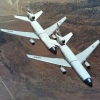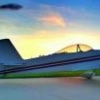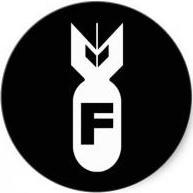I am reposting the below because CDR. John 'Boot' Nethersole, FAA, RN (ret) passed away on 8 Feb 2012. I was proud to have known him. He and his wife invited me over to England to attend the decommisioning of a squadron he had once commanded, 801.
Good guy.
Another WWII vet and a superb pilot who did the transition from the high-powered piston engine fighters to jets into the 1960s. I've had drinks with him here in the US and visited he and his wife in the UK. At 80, when I visited, he still was able to run hard.
Some of his stories in immediate post-War Germany had me rolling on the floor.
Things Were A Bit Different Then
“At the end of World War II, I led the capture of Tokyo. Well, actually, one of four forts that ringed the entrance to Tokyo Bay.” So began a fascinating morning with Commander John ‘Boot’ Nethersole, Royal Navy (ret.).
“I was just out of Dartmouth (the Royal Navy’s officer academy) and assigned to the cruiser, HMS Newfoundland. I led one of two Royal Navy (RN) landing parties against two of the forts while some US Marines captured the other two on the other side of the entrance.
“So here I am, a young midshipman leading my lot of sailors onto the beach and up the hill, yelling and screaming to keep our courage up since we really didn’t know what kind of reaction the Japanese would produce.
“It was all anti-climatic really, for when we got to the top, there was no one there and we were standing around kicking the sand with our boots and nothing to do. Finally, from behind a beached cutter (kind of a long row boat), up pops this white flag on a pole.
“I advanced to the cutter and stuck my .45 around the bow, to find three Japanese soldiers attached to the other end of the pole, kneeling and shaking in their shoes.
“So with their surrender, I lay claim to having captured Tokyo!” This is only one of the many stories ‘Boot’ recounted with tongue firmly in cheek.
Shortly after this episode, he applied to the RN’s Fleet Air Arm (FAA) to be a pilot.
At that time, the Royal Air Force taught FAA fledglings until they were awarded their wings at which point the new pilots posted to a FAA operational training unit (OTU). It was at OTU that Nethersole first flew in navalized variants of the famous Supermarine Spitfire.
Of these ‘Seafires,’ Nethersole recalled, “Really a lovely little airplane to fly; smelled strongly of petrol when you flew it upside down.”
Moving on to the second part of his OTU, he flew another 100 hours in the Hawker Sea Fury, learning basic fighter maneuvers, practicing air to air and air to ground attacks, including his first live firing of 20mm cannons, rockets and bombs before posting to his first operational squadron, No. 802. 802’s senior pilot was none other than famed test pilot Eric ‘Winkle’ Brown.
802 Squadron came aboard the carrier HMS Vengeance and cruised as part of both the Home and Mediterranean Fleets during Nethersole’s first squadron tour, 1949-1951. Nethersole recounts what flying the Sea Fury was like,
“Unless there was no wind over the deck, which almost never happened, we did free take-offs. Spotted as far aft as we could, we poured the power to the 18-cylinder Centaurus radial and released the brakes.
“When really heavy, carrying a full load of bombs for example, some Sea Furies could use RATOG – rocket assisted take-off. You fired these off as you started forward and the rockets provided several hundred pounds of extra ‘push’ to get airborne.
“Although RATOG was seldom used, my squadron commander had had an exciting experience while using them during the Korean War. He was carrying 1000 pounders under each wing, full fuel and ammunition, really rather heavy.
“During his pre-flight, he forgot to switch on the masterswitch for the RATOG bottles. Spotted in the front rank for take-off, he was about even with the carrier’s island. When the deck officer gave him the launch signal, he applied full throttle and started rolling forward. As he moved, he hit the ignition switch for the RATOG and, of course, nothing happened, but it was too late for him to stop on the remaining deck.
“Over the bow he went, everyone expecting the splash. That never happened and shortly thereafter, he pulled ahead of the ship at nil feet above the water. He had been unbelievably lucky and supremely skilled to take advantage of ‘ground effect’ and stay out of the water (Ground effect – the phenomenon where air is compressed between the underside of a low flying aircraft and the surface, in this case the ocean. It occurs when the height of the aircraft is less than one wingspan above the surface.)
“So he was really in a bind; too slow to climb out of ground effect or he’d stall and crash and unable to gain speed since he couldn’t dive to pick up some extra knots. When last seen, he was flying over the horizon with his tailwheel sometimes kicking up spray. He actually flew that way until he burned off enough fuel to lighten his airplane and manage to climb at the lighter weight!
“When returning to the ship, we’d typically be in echelon formation, entering the pattern on the starboard side of the ship, breaking off at ten second intervals to set up landings. We strove to land each aircraft within 15-20 seconds of the each other.
“When Mother Nature provided wind and the ship was charging into it for all she was worth, we’d usually have 30-40 knots over the deck when on finals for landing in a continuously curving approach to the stern. We had to fly like that so we could keep the batsman in sight. With the twelve feet of nose and engine in front of the cockpit, if we came straight in, we’d be blind in the three-point landing attitude.
“Holding 80-82 knots, we kept our eyes glued to the batsman’s signals, when he gave us the ‘cut’ we pulled the power and settled to the deck, hoping we’d catch one of the ten cross-deck wires with the tailhook. If we didn’t, we faced the prospect of taking one of two wire barriers that protected the aircraft parked towards the bow. The barriers would play havoc with the fighter’s propeller and wings, but it would stop the aircraft from plowing into the airpark on deck forward.
“If, as happened from time to time, a chap hit rather hard and bounced, he’d balloon over the wires and the barriers and go into the airpark. At best, the fighter would be a write-off and maybe, one or two others. At worst, a collision would trigger explosions and damage or destroy many aircraft.”
It was ashore,however, that ‘Boot’ tells one of his funniest ‘there I was’ stories.
“We had completed our last day of armaments camp, flying out of the airfield at Sylt, in the Friesian Islands off northern Germany. We had quite a party to celebrate the end of our encampment and I had a bit much to drink.
“Next morning, we were to be off back to our base at Wunstorf. Naturally, the weather was terrible - cold, wet, low hanging cloud that went up to who knows what altitude, so we delayed.
“I found myself a choice piece of hangar wall to lean against and had a nap. Next thing I know, I’m shaken awake with a “Right, your off!”
“I jumped in my airplane, started it up and fell into the taxiing queue and waited my turn for take-off. I lined up on the runway, added power and took off, immediately going into the clouds and onto instruments.
“When I finally broke out of the clouds on top, there wasn’t another airplane to be seen. I also discovered I’d lost my radio. “No problem,” I thought, “I’ll just set course for home and meet up with the chaps there.”
“Well, without the concentration required for formation flying and the soothing drone of the Centaurus, I soon drifted off for a bit. When I awoke, I found myself well off-course, and if my hurried calculations were correct, probably over the Russian Zone of Occupation!
“I wasn’t really sure of my position and couldn’t call for a fix, but I knew I didn’t want to be were I was and that if I flew west, I should eventually find the coast and from there, I could determine my position.
“So, I flew away, eyes open for either a recognizable landmark or a Russian escort. I desperately wanted the former and not the latter!
“Eventually, I did reach the coast over Belgium, so I flew north, looking for a more definitive navigational reference than the sea. Petrol, at this point, was becoming a real concern so I knew I had to do something soon.
“I spotted a lovely stretch of autobahn beneath me, so decided that would do. Remember, this is 1948, so there was not a lot of traffic on the road then.
“I landed quite nicely, folded the Fury’s wings, and taxied to a carriage way link shut down and waited for a car to come by. Luckily, the next one by was actually a German police car, so we were able to determine my position and what course I needed to get home.
“I had the German chap stop traffic, unfolded the wings, and took off.
I arrived back at Wunstorf to find my squadron thinking I had crashed as the time expired since we took off from Sylt had long exceeded the fuel endurance of my Sea Fury. Luckily, I was able to explain most of my story and no one was the worse for wear.”
In another episode, Nethersole tells of what might be the last time that a British aircraft was ‘fired upon’ by the recently defeated Germans.
“I was flat-hatting over the fields of northern Germany when I came upon a German farmer just finishing up loading his hay wagon.
“The farmer raised his three-pronged pitchfork like a javelin as I flew by. I thought, “There is no bloody way he can do anything thing with that,” so I pressed in.
“I roared right above his piled high wagon, leaving a cloud of dust and straw in my wake and an unloaded wagon. But I’ll be damned if I also didn’t feel a ‘thunk’ on my wing! When I landed, there, impaled in my port wing’s leading edge was the fork and foot or two of the handle of the man’s pitchfork. Nice shot, that!”
During his initial tour, Nethersole’s flying ability was recognized by ‘Winkle’ Brown as he was handpicked by Brown to be one of 802’s aerobatic demonstration team pilots. In his auto-biography, “Wings on My Sleeve,” Brown wrote of working the team to such a fine pitch of airmanship that he could feel pressure on his tailplanes from the air being compressed and bunching up in front of the ‘box’ man’s propeller. Tight formation flying, indeed!
After finishing his first operational tour, Nethersole was selected for the Air Weapons Officers Course where he became schooled in the latest weapons and tactics to best employ those weapons by tactical aircraft and assigned to 702 Squadron.
It was with 702 that he had a very close call in one of the early jets, the Supermarine Attacker.
“The Attacker was really just not a good airplane. I think the Navy bought it just so it could get a jet into service.”
Derived from Supermarine’s Spiteful which itself was a derivative of the Spitfire, the Attacker kept the Spiteful’s straight wings and tailwheel landing gear arrangement. Fitted with a 5,000lb thrust Nene turbojet, the Attacker had several fuel tanks, including an ungainly auxiliary ventral tank to increase its ‘legs.’ One feature in its fuel system that would directly and dramatically affect Nethersole is the one that had all tanks flow to one 73-gallon feeder tank.
If that tank should empty due to fuel pump failure or the other tanks not feeding for whatever reason, it didn’t matter how much gas was aboard, the thirsty Nene would soon sputter out. That is what happened to Boot.
“We made a formation take-off and climbed into very thick cloud cover. Trying to maintain my formation in those conditions, I really couldn’t afford to keep my head inside the cockpit. By the time we popped out on top and could gain a few feet of separation, the damage was done. A quick glance at my fuel gauges showed the other tanks still full, but my feeder tank nearly empty! Obviously, it wasn’t flowing and I was just a few minutes from a flame out.
“I nearly made it, but not quite. The fuel ran out and the engine quit while I was still a bit too far out. I couldn’t stretch the glide quite far enough and wound up about 100 yards shy of the airfield. Luckily, it was grass and I was able to touchdown with some control because the airfield boundary fence made of concrete posts with wire between them was quickly looming larger. I managed to kick enough rudder to steer the fuselage between two posts, sheering the port wing off completely. I came to rest very nearly on the runway edge inside the airfield.
“Now the thing was, there was a group of ‘plane spotters’ parked outside the fence watching the aircraft come and go. After I punched through the fence, they just kind of wandered in and stood in a semi-circle around my aircraft. Since it was now on fire that perhaps wasn’t the wisest thing they could have done.
“But I had other problems than the crowd’s welfare to worry about. My canopy was jammed shut and I couldn’t budge it. I tried with some hand gestures to get one of the crowd to come forward and grab the emergency canopy release lever on the side of the fuselage, but couldn’t get the idea across. As I was beginning to cook, I was not happy at the miscommunication.
“Finally, I was able to shoulder the canopy open enough to jump out and get away from the burning jet. I started shoo’ing the crowd away because there was still quite a lot of gas that would be going up any second. One wing tank did flare up just as I jumped, leaving me with burns on my face around the edge of my oxygen mask.
“About then, the station commander came along in his car. He had been driving along the peri track on his way to one of the other squadrons and saw me crash. He said, “Right, Boot, you take my car to the Infirmary and I’ll deal with this lot.”
A few years later, in a fortuitous meeting in the ‘loo’ at RNAS Lossiemouth, Boot ran into a friend, Lt. Cdr. Les Baker, the CO of 801 Squadron. Baker asked Boot what he was up to as 801 had need of a senior pilot. Nethersole, thinking quickly, said that was just what he was looking for. Baker then rang up the Admiralty and the deed was done.
Tragically, Baker was killed at sea during 801’s Far East cruise aboard HMS Centaur. Flying Hawker Seahawk FGA.4s, Baker missed a loose nose tank fuel cap during his preflight inspection, as did the Centaur’s deck crew. During the catapult shot, the acceleration forces flung the cap off and raw fuel streamed out and into the spring-loaded low speed engine bay air vents over the Seahawk’s Nene engine. The fuel ignited and Baker’s jet blew up right off the bow.
Nethersole picked up temporary, later permanent, command of 801. At that time, he was the youngest squadron commander in the Navy.
After rotating numerous times between sea and shore duties including command of his own ship, the frigate HMS Loch Alvie, he assumed the duties of Commander (Air) at RNAS Lossiemouth.
It was at Lossiemouth, that Boot claimed another bit of history. He made the last flight in the World War II-era Fairey Fulmar. The first eight-gun fighter in Royal Navy history, the Fulmar failed to live up to expectations during its operational service.
Lossiemouth’s Fulmar served as the station ‘hack.’ By Nethersole’s time, the aging fighter was unsupportable. Boot received a message from the Admiralty directing him to ground the aircraft.
Recognizing his chance for small piece of aviation history, Nethersole took the Fulmar up for one last flight. Upon landing, he shut down the Fulmar’s Rolls Royce Merlin, thinking, “Well, that’s that.”
A few hours later, back in his office, he glanced out the window to see the Fulmar taxiing to the active runway. The Chief Flying Instructor had decided HE wanted to be the last to fly the Fulmar and away he went.
Rank does have its privileges, so upon the instructor’s return, Boot again took up the Fulmar, landed, then ordered that no one else was to fly the damn thing!
Fast forward nearly 25 years to the FAA Museum at RNAS Yeovilton. Visiting the Museum, Nethersole overheard a guide lecturing a group on that very same Fulmar in the Museum’s collection. The guide got it wrong and Nethersole found himself unable to resist commenting.
Thrilled to be able to set the record straight, the Museum has since requested, and upon his death, will receive Nethersole’s logbook with its nearly 4,000 hours including the Fulmar’s final flight.
Says Boot now of his time as a pilot compared to today’s much more regulated times, “Things were a bit different then.”








